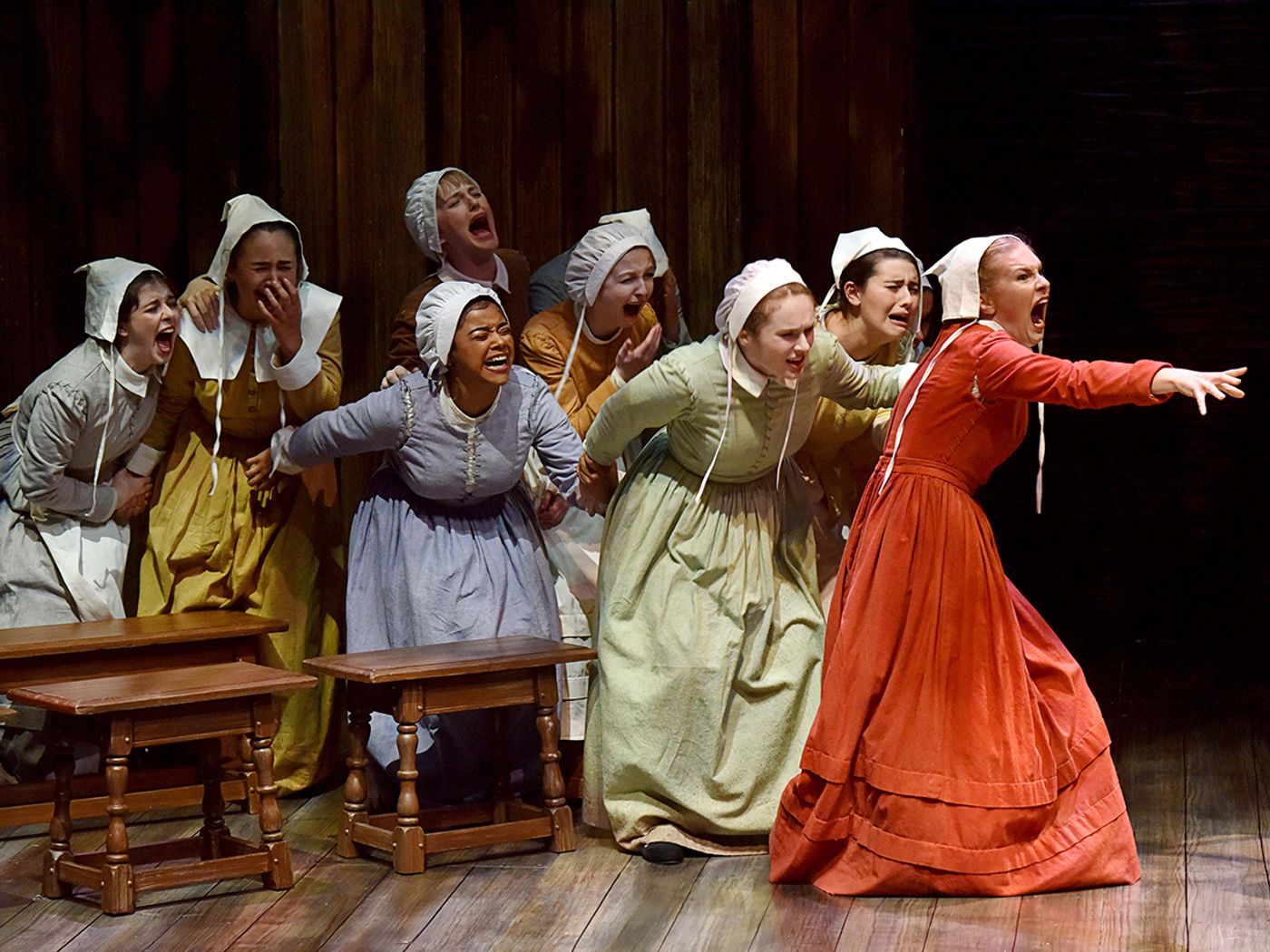Review: THE CRUCIBLE at Marian Theatre, Santa Maria
 The Crucible: A Play for All Times
The Crucible: A Play for All Times
PCPA's current production, The Crucible, transports the audience through a journey of fear and pity, inspiring to the heart and mind. We are presented with the community of Salem circa 1692. The Puritans there believe that witches are among them, killing their cattle and murdering their children. A group of girls has been discovered dancing together in the woods; they escape punishment by accusing others of being witches who have possessed them and supplanted their will. The girls of Salem have suffered brutal whippings and constant surveillance. Their accusations function as revenge and release. The girls' hysteria reveals the deeper rot in Salem, the murder of the innocent by fully grown adults for material or personal gain under the banner of godliness.
Set designer Jason Bolen conjures the world of The Crucible with an ingeniously adaptable and poetic set. Upstage of the action, a wall consisting of vertical wooden planks transform into multiple settings for the drama--from the wilds of the woods to the indoors of a Salem meeting house. To create swift scene changes, sections of the wooden planks move up and down like a sash window, or, to my mind, like the efficient movement of the guillotine, another instrument of state-sponsored terror. Lighting design by Tim Thistleton created a pervading sense of darkness encroaching around the action, as though waiting to envelop the characters. The scenic space thereby supports the emotional tenor of the drama as a metaphor for the characters' insecurity and the mysterious nature of the natural world and of their Puritan god.
Director Roger DeLaurier adds an opening scene of the Puritan girls dancing in the woods led by Tituba (Méami Maszewski), a slave from Barbados. This scene does not appear in Arthur Miller's original play text, but many productions have added it since the 1996 film of The Crucible first introduced it (its screenplay was written by Miller). The precise nature of what happened when the girls danced in the woods (if they practiced witchcraft, if they cast spells, if they drank blood, if some of them were naked while they danced) is disputed by the characters in the subsequent action. When the activities of the girls are unknown to the audience, they are allowed to judge the action, considering only the credibility and motives of the characters testifying. By including the audience in a first-hand view of the dancing, perhaps the production detracts from the opportunity to judge the characters without prejudice. The jubilant circular dance does make for a vibrant scene, brimming with the energy of pent-up emotional and physical suppression and introduces the power the girls find in a collective.
As the witch craze takes hold of Salem, only the outcasts and lowly are named as witches, but gradually the persecution encompasses people widely thought to be morally impeccable, like the wise and holy Rebecca Nurse (finely played by Rosh Wright). The accused "witches" who confess are released; those who deny their devil-worship are killed. Puritan farmer, John Proctor (Andrew Philpot) believes that the sordid trials could never touch him or his devout wife, Elizabeth (Polly Firestone Walker), but, of course, the Puritan authorities come for both of them. The leader of the accusing girls, 17-year-old Abigail Williams (Skye Privat), had been fired by Elizabeth Proctor from her position as a servant before the present action of the play. Elizabeth had discovered that her husband was having sex with Abigail. When Abigail accuses Elizabeth of witchcraft, Abigail wields a newly found power in this oppressive patriarchal theocracy. The role of Abigail would be easy for an actor to over-do: after all, Abigail is an actor of sorts, pretending to be innocent, fomenting emotions, simultaneously feigning hysteria and truly being hysterical. Skye Privat plays Abigail with convincing realism anchored in her steadfast intention to regain John Proctor's affection.
When Miller wrote The Crucible in 1953, it was widely interpreted as a parable for the menace of the McCarthy hearings, the communist witch hunt that ensnared Miller himself. The Crucible has endured because its allegorical dimensions make it a relatable tale of the destructive power of collective fantasy in any age. The audience with whom I watched The Crucible responded to the story's resonance with contemporary American politics. For example, everyone collectively snickered when Deputy-Governor Danforth (Mark Booher) declared that he would get to the bottom of "the swamp."
Also worthy of note is the character of Reverend John Hale, deftly depicted by George Walker. Reverend Hale realizes a bit too late that he has made an irredeemable error in supporting the witch trials. His eagerness to discover witches early in the play makes the audience distrustful of him, but when he sees that his confidence in the infallibility of the court proceedings has been woefully misplaced, it's vital that the audience believes in his about-face. As the play concludes, Hale plays a special role as the audience's surrogate because he bears witness, as we do, to the full scope of the tragedy. I found Walker's pained, silent expressions as moving as his speeches.
Go see The Crucible, a play for our times.
Reader Reviews
Videos

